Comprehensive Corporate Finance Assessment of Hitachi Group (Report)
VerifiedAdded on 2020/10/04
|8
|2709
|43
Report
AI Summary
This report provides a comprehensive corporate finance assessment of Hitachi Group, a major multinational conglomerate. The analysis includes an overview of the company, its valuation based on various metrics like price-to-earnings and price-to-book ratios, and a historical perspective on these valuations. The report delves into yield analysis, financial performance using key ratios, and a detailed examination of differences such as net asset value and comparable ratios. It further explores discounted free cash flow and concludes with an overall evaluation of Hitachi's financial health and performance over a period of time, supported by statistical data and references to relevant financial literature. The report assesses the company's profitability, liquidity, and solvency, providing insights into its financial stability and stakeholder interests.
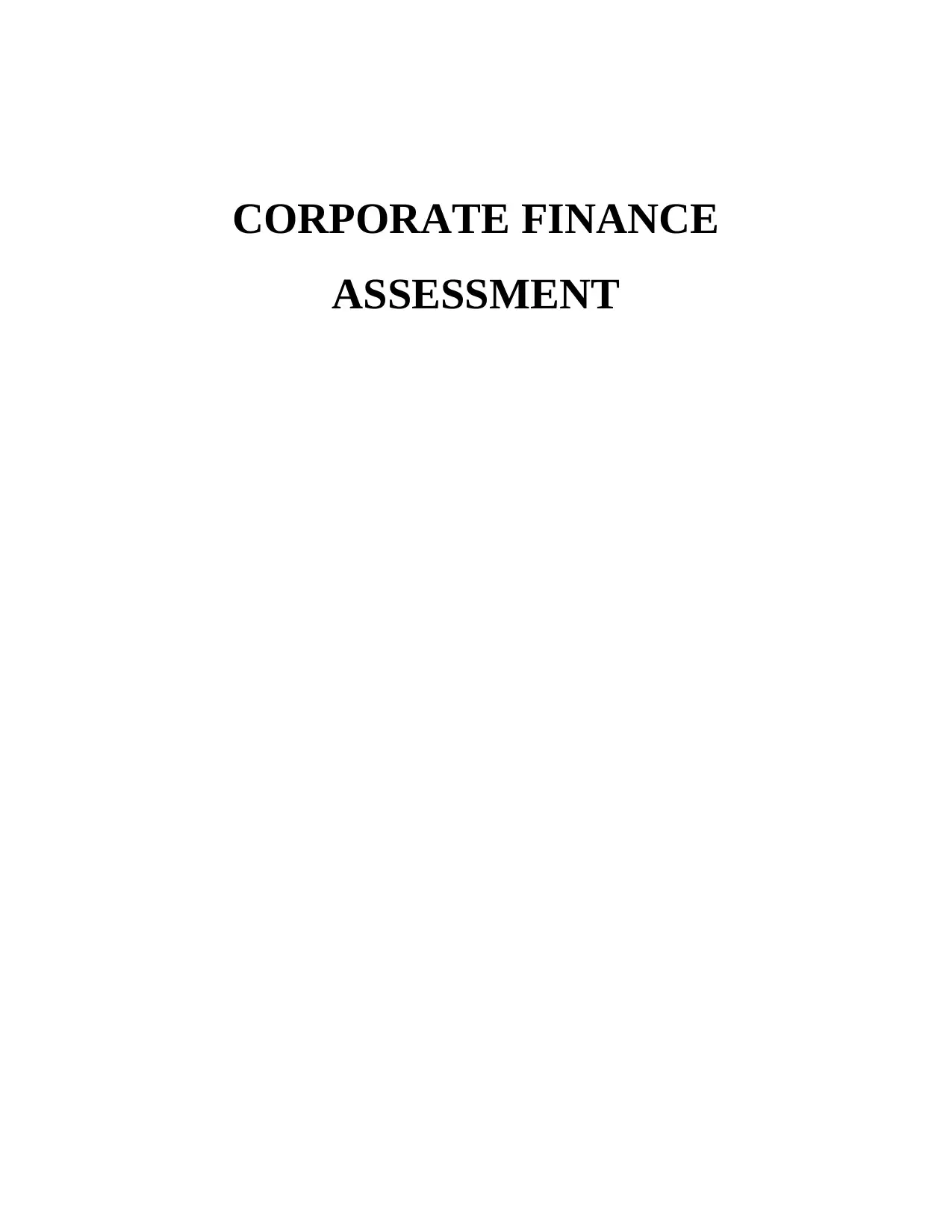
CORPORATE FINANCE
ASSESSMENT
ASSESSMENT
Paraphrase This Document
Need a fresh take? Get an instant paraphrase of this document with our AI Paraphraser
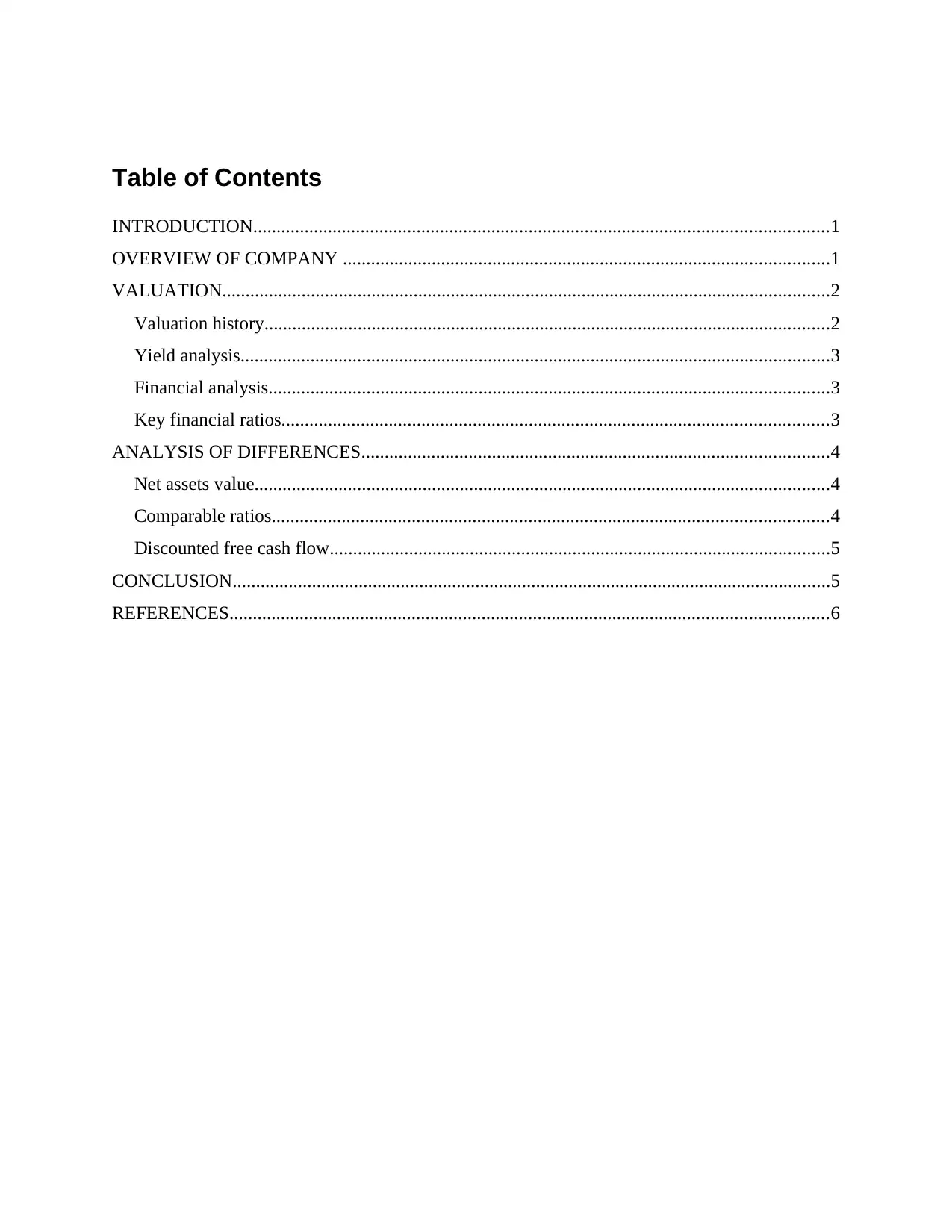
Table of Contents
INTRODUCTION...........................................................................................................................1
OVERVIEW OF COMPANY ........................................................................................................1
VALUATION..................................................................................................................................2
Valuation history.........................................................................................................................2
Yield analysis..............................................................................................................................3
Financial analysis........................................................................................................................3
Key financial ratios.....................................................................................................................3
ANALYSIS OF DIFFERENCES....................................................................................................4
Net assets value...........................................................................................................................4
Comparable ratios.......................................................................................................................4
Discounted free cash flow...........................................................................................................5
CONCLUSION................................................................................................................................5
REFERENCES................................................................................................................................6
INTRODUCTION...........................................................................................................................1
OVERVIEW OF COMPANY ........................................................................................................1
VALUATION..................................................................................................................................2
Valuation history.........................................................................................................................2
Yield analysis..............................................................................................................................3
Financial analysis........................................................................................................................3
Key financial ratios.....................................................................................................................3
ANALYSIS OF DIFFERENCES....................................................................................................4
Net assets value...........................................................................................................................4
Comparable ratios.......................................................................................................................4
Discounted free cash flow...........................................................................................................5
CONCLUSION................................................................................................................................5
REFERENCES................................................................................................................................6
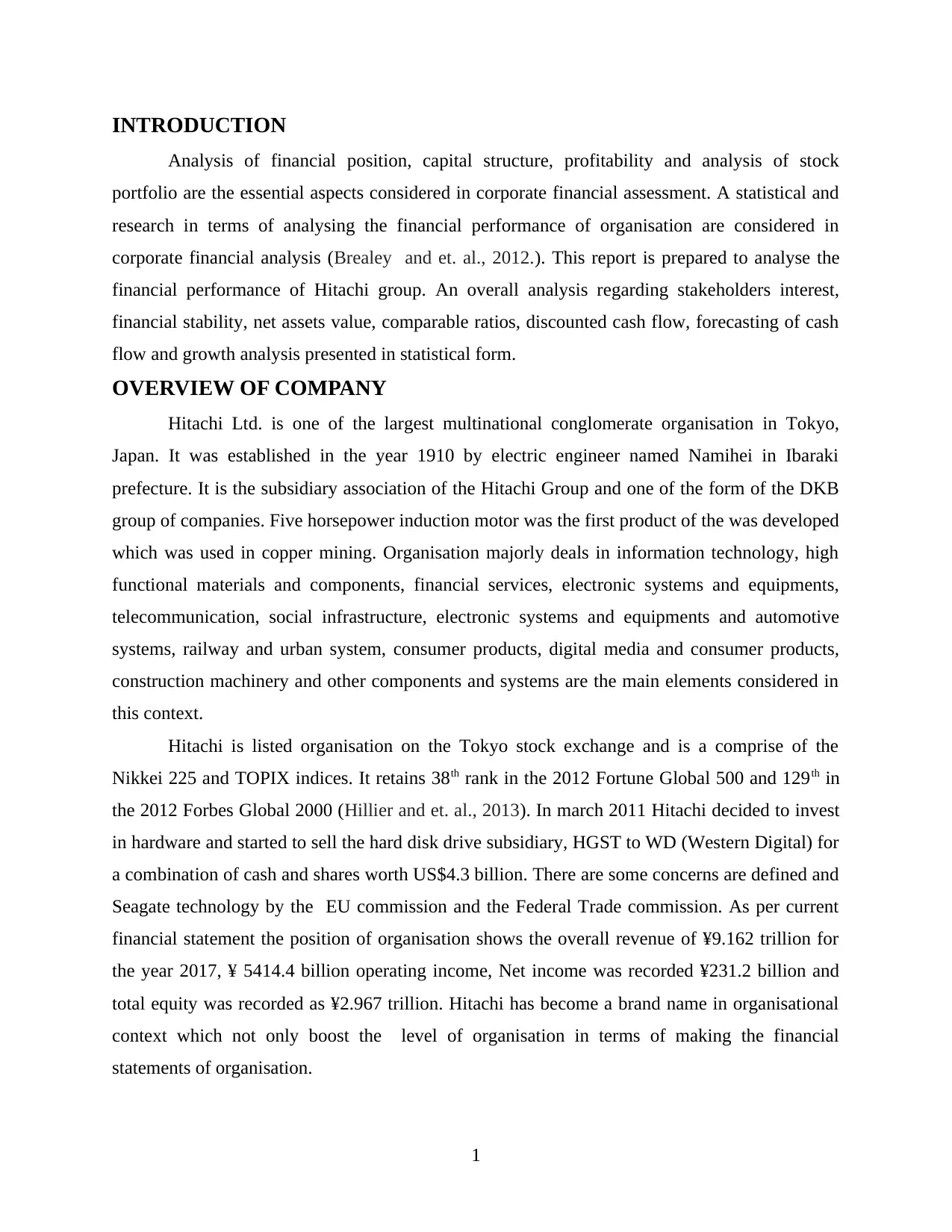
INTRODUCTION
Analysis of financial position, capital structure, profitability and analysis of stock
portfolio are the essential aspects considered in corporate financial assessment. A statistical and
research in terms of analysing the financial performance of organisation are considered in
corporate financial analysis (Brealey and et. al., 2012.). This report is prepared to analyse the
financial performance of Hitachi group. An overall analysis regarding stakeholders interest,
financial stability, net assets value, comparable ratios, discounted cash flow, forecasting of cash
flow and growth analysis presented in statistical form.
OVERVIEW OF COMPANY
Hitachi Ltd. is one of the largest multinational conglomerate organisation in Tokyo,
Japan. It was established in the year 1910 by electric engineer named Namihei in Ibaraki
prefecture. It is the subsidiary association of the Hitachi Group and one of the form of the DKB
group of companies. Five horsepower induction motor was the first product of the was developed
which was used in copper mining. Organisation majorly deals in information technology, high
functional materials and components, financial services, electronic systems and equipments,
telecommunication, social infrastructure, electronic systems and equipments and automotive
systems, railway and urban system, consumer products, digital media and consumer products,
construction machinery and other components and systems are the main elements considered in
this context.
Hitachi is listed organisation on the Tokyo stock exchange and is a comprise of the
Nikkei 225 and TOPIX indices. It retains 38th rank in the 2012 Fortune Global 500 and 129th in
the 2012 Forbes Global 2000 (Hillier and et. al., 2013). In march 2011 Hitachi decided to invest
in hardware and started to sell the hard disk drive subsidiary, HGST to WD (Western Digital) for
a combination of cash and shares worth US$4.3 billion. There are some concerns are defined and
Seagate technology by the EU commission and the Federal Trade commission. As per current
financial statement the position of organisation shows the overall revenue of ¥9.162 trillion for
the year 2017, ¥ 5414.4 billion operating income, Net income was recorded ¥231.2 billion and
total equity was recorded as ¥2.967 trillion. Hitachi has become a brand name in organisational
context which not only boost the level of organisation in terms of making the financial
statements of organisation.
1
Analysis of financial position, capital structure, profitability and analysis of stock
portfolio are the essential aspects considered in corporate financial assessment. A statistical and
research in terms of analysing the financial performance of organisation are considered in
corporate financial analysis (Brealey and et. al., 2012.). This report is prepared to analyse the
financial performance of Hitachi group. An overall analysis regarding stakeholders interest,
financial stability, net assets value, comparable ratios, discounted cash flow, forecasting of cash
flow and growth analysis presented in statistical form.
OVERVIEW OF COMPANY
Hitachi Ltd. is one of the largest multinational conglomerate organisation in Tokyo,
Japan. It was established in the year 1910 by electric engineer named Namihei in Ibaraki
prefecture. It is the subsidiary association of the Hitachi Group and one of the form of the DKB
group of companies. Five horsepower induction motor was the first product of the was developed
which was used in copper mining. Organisation majorly deals in information technology, high
functional materials and components, financial services, electronic systems and equipments,
telecommunication, social infrastructure, electronic systems and equipments and automotive
systems, railway and urban system, consumer products, digital media and consumer products,
construction machinery and other components and systems are the main elements considered in
this context.
Hitachi is listed organisation on the Tokyo stock exchange and is a comprise of the
Nikkei 225 and TOPIX indices. It retains 38th rank in the 2012 Fortune Global 500 and 129th in
the 2012 Forbes Global 2000 (Hillier and et. al., 2013). In march 2011 Hitachi decided to invest
in hardware and started to sell the hard disk drive subsidiary, HGST to WD (Western Digital) for
a combination of cash and shares worth US$4.3 billion. There are some concerns are defined and
Seagate technology by the EU commission and the Federal Trade commission. As per current
financial statement the position of organisation shows the overall revenue of ¥9.162 trillion for
the year 2017, ¥ 5414.4 billion operating income, Net income was recorded ¥231.2 billion and
total equity was recorded as ¥2.967 trillion. Hitachi has become a brand name in organisational
context which not only boost the level of organisation in terms of making the financial
statements of organisation.
1
⊘ This is a preview!⊘
Do you want full access?
Subscribe today to unlock all pages.

Trusted by 1+ million students worldwide
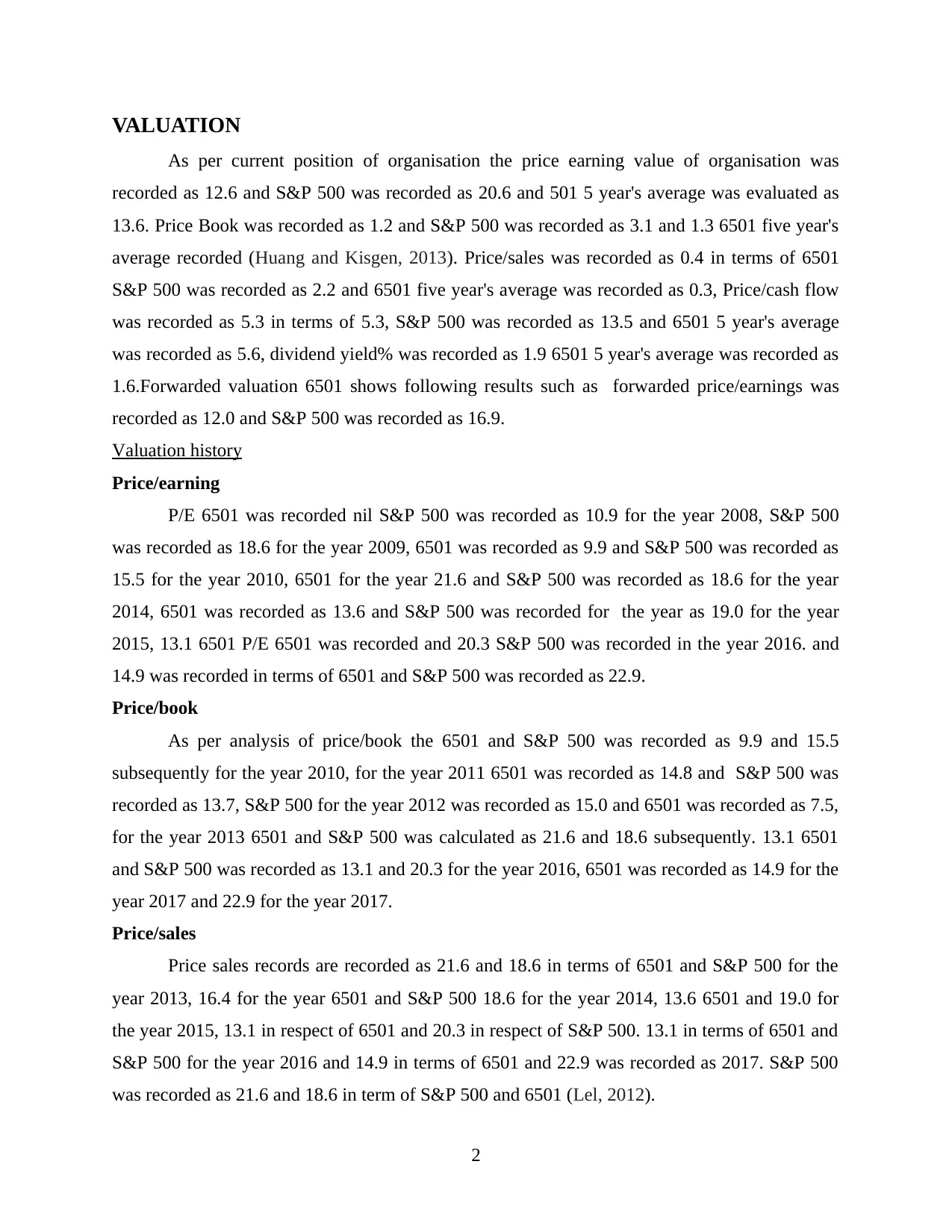
VALUATION
As per current position of organisation the price earning value of organisation was
recorded as 12.6 and S&P 500 was recorded as 20.6 and 501 5 year's average was evaluated as
13.6. Price Book was recorded as 1.2 and S&P 500 was recorded as 3.1 and 1.3 6501 five year's
average recorded (Huang and Kisgen, 2013). Price/sales was recorded as 0.4 in terms of 6501
S&P 500 was recorded as 2.2 and 6501 five year's average was recorded as 0.3, Price/cash flow
was recorded as 5.3 in terms of 5.3, S&P 500 was recorded as 13.5 and 6501 5 year's average
was recorded as 5.6, dividend yield% was recorded as 1.9 6501 5 year's average was recorded as
1.6.Forwarded valuation 6501 shows following results such as forwarded price/earnings was
recorded as 12.0 and S&P 500 was recorded as 16.9.
Valuation history
Price/earning
P/E 6501 was recorded nil S&P 500 was recorded as 10.9 for the year 2008, S&P 500
was recorded as 18.6 for the year 2009, 6501 was recorded as 9.9 and S&P 500 was recorded as
15.5 for the year 2010, 6501 for the year 21.6 and S&P 500 was recorded as 18.6 for the year
2014, 6501 was recorded as 13.6 and S&P 500 was recorded for the year as 19.0 for the year
2015, 13.1 6501 P/E 6501 was recorded and 20.3 S&P 500 was recorded in the year 2016. and
14.9 was recorded in terms of 6501 and S&P 500 was recorded as 22.9.
Price/book
As per analysis of price/book the 6501 and S&P 500 was recorded as 9.9 and 15.5
subsequently for the year 2010, for the year 2011 6501 was recorded as 14.8 and S&P 500 was
recorded as 13.7, S&P 500 for the year 2012 was recorded as 15.0 and 6501 was recorded as 7.5,
for the year 2013 6501 and S&P 500 was calculated as 21.6 and 18.6 subsequently. 13.1 6501
and S&P 500 was recorded as 13.1 and 20.3 for the year 2016, 6501 was recorded as 14.9 for the
year 2017 and 22.9 for the year 2017.
Price/sales
Price sales records are recorded as 21.6 and 18.6 in terms of 6501 and S&P 500 for the
year 2013, 16.4 for the year 6501 and S&P 500 18.6 for the year 2014, 13.6 6501 and 19.0 for
the year 2015, 13.1 in respect of 6501 and 20.3 in respect of S&P 500. 13.1 in terms of 6501 and
S&P 500 for the year 2016 and 14.9 in terms of 6501 and 22.9 was recorded as 2017. S&P 500
was recorded as 21.6 and 18.6 in term of S&P 500 and 6501 (Lel, 2012).
2
As per current position of organisation the price earning value of organisation was
recorded as 12.6 and S&P 500 was recorded as 20.6 and 501 5 year's average was evaluated as
13.6. Price Book was recorded as 1.2 and S&P 500 was recorded as 3.1 and 1.3 6501 five year's
average recorded (Huang and Kisgen, 2013). Price/sales was recorded as 0.4 in terms of 6501
S&P 500 was recorded as 2.2 and 6501 five year's average was recorded as 0.3, Price/cash flow
was recorded as 5.3 in terms of 5.3, S&P 500 was recorded as 13.5 and 6501 5 year's average
was recorded as 5.6, dividend yield% was recorded as 1.9 6501 5 year's average was recorded as
1.6.Forwarded valuation 6501 shows following results such as forwarded price/earnings was
recorded as 12.0 and S&P 500 was recorded as 16.9.
Valuation history
Price/earning
P/E 6501 was recorded nil S&P 500 was recorded as 10.9 for the year 2008, S&P 500
was recorded as 18.6 for the year 2009, 6501 was recorded as 9.9 and S&P 500 was recorded as
15.5 for the year 2010, 6501 for the year 21.6 and S&P 500 was recorded as 18.6 for the year
2014, 6501 was recorded as 13.6 and S&P 500 was recorded for the year as 19.0 for the year
2015, 13.1 6501 P/E 6501 was recorded and 20.3 S&P 500 was recorded in the year 2016. and
14.9 was recorded in terms of 6501 and S&P 500 was recorded as 22.9.
Price/book
As per analysis of price/book the 6501 and S&P 500 was recorded as 9.9 and 15.5
subsequently for the year 2010, for the year 2011 6501 was recorded as 14.8 and S&P 500 was
recorded as 13.7, S&P 500 for the year 2012 was recorded as 15.0 and 6501 was recorded as 7.5,
for the year 2013 6501 and S&P 500 was calculated as 21.6 and 18.6 subsequently. 13.1 6501
and S&P 500 was recorded as 13.1 and 20.3 for the year 2016, 6501 was recorded as 14.9 for the
year 2017 and 22.9 for the year 2017.
Price/sales
Price sales records are recorded as 21.6 and 18.6 in terms of 6501 and S&P 500 for the
year 2013, 16.4 for the year 6501 and S&P 500 18.6 for the year 2014, 13.6 6501 and 19.0 for
the year 2015, 13.1 in respect of 6501 and 20.3 in respect of S&P 500. 13.1 in terms of 6501 and
S&P 500 for the year 2016 and 14.9 in terms of 6501 and 22.9 was recorded as 2017. S&P 500
was recorded as 21.6 and 18.6 in term of S&P 500 and 6501 (Lel, 2012).
2
Paraphrase This Document
Need a fresh take? Get an instant paraphrase of this document with our AI Paraphraser
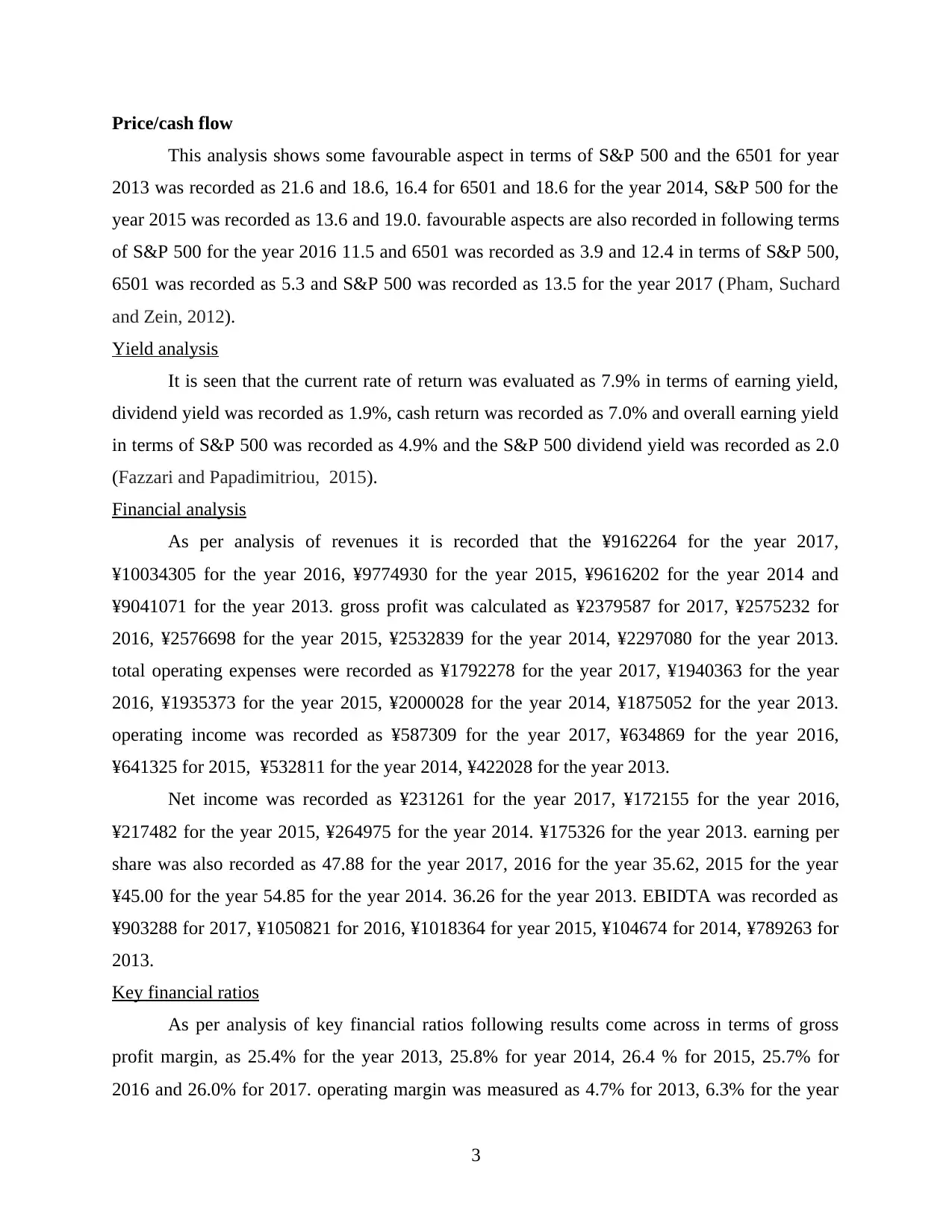
Price/cash flow
This analysis shows some favourable aspect in terms of S&P 500 and the 6501 for year
2013 was recorded as 21.6 and 18.6, 16.4 for 6501 and 18.6 for the year 2014, S&P 500 for the
year 2015 was recorded as 13.6 and 19.0. favourable aspects are also recorded in following terms
of S&P 500 for the year 2016 11.5 and 6501 was recorded as 3.9 and 12.4 in terms of S&P 500,
6501 was recorded as 5.3 and S&P 500 was recorded as 13.5 for the year 2017 (Pham, Suchard
and Zein, 2012).
Yield analysis
It is seen that the current rate of return was evaluated as 7.9% in terms of earning yield,
dividend yield was recorded as 1.9%, cash return was recorded as 7.0% and overall earning yield
in terms of S&P 500 was recorded as 4.9% and the S&P 500 dividend yield was recorded as 2.0
(Fazzari and Papadimitriou, 2015).
Financial analysis
As per analysis of revenues it is recorded that the ¥9162264 for the year 2017,
¥10034305 for the year 2016, ¥9774930 for the year 2015, ¥9616202 for the year 2014 and
¥9041071 for the year 2013. gross profit was calculated as ¥2379587 for 2017, ¥2575232 for
2016, ¥2576698 for the year 2015, ¥2532839 for the year 2014, ¥2297080 for the year 2013.
total operating expenses were recorded as ¥1792278 for the year 2017, ¥1940363 for the year
2016, ¥1935373 for the year 2015, ¥2000028 for the year 2014, ¥1875052 for the year 2013.
operating income was recorded as ¥587309 for the year 2017, ¥634869 for the year 2016,
¥641325 for 2015, ¥532811 for the year 2014, ¥422028 for the year 2013.
Net income was recorded as ¥231261 for the year 2017, ¥172155 for the year 2016,
¥217482 for the year 2015, ¥264975 for the year 2014. ¥175326 for the year 2013. earning per
share was also recorded as 47.88 for the year 2017, 2016 for the year 35.62, 2015 for the year
¥45.00 for the year 54.85 for the year 2014. 36.26 for the year 2013. EBIDTA was recorded as
¥903288 for 2017, ¥1050821 for 2016, ¥1018364 for year 2015, ¥104674 for 2014, ¥789263 for
2013.
Key financial ratios
As per analysis of key financial ratios following results come across in terms of gross
profit margin, as 25.4% for the year 2013, 25.8% for year 2014, 26.4 % for 2015, 25.7% for
2016 and 26.0% for 2017. operating margin was measured as 4.7% for 2013, 6.3% for the year
3
This analysis shows some favourable aspect in terms of S&P 500 and the 6501 for year
2013 was recorded as 21.6 and 18.6, 16.4 for 6501 and 18.6 for the year 2014, S&P 500 for the
year 2015 was recorded as 13.6 and 19.0. favourable aspects are also recorded in following terms
of S&P 500 for the year 2016 11.5 and 6501 was recorded as 3.9 and 12.4 in terms of S&P 500,
6501 was recorded as 5.3 and S&P 500 was recorded as 13.5 for the year 2017 (Pham, Suchard
and Zein, 2012).
Yield analysis
It is seen that the current rate of return was evaluated as 7.9% in terms of earning yield,
dividend yield was recorded as 1.9%, cash return was recorded as 7.0% and overall earning yield
in terms of S&P 500 was recorded as 4.9% and the S&P 500 dividend yield was recorded as 2.0
(Fazzari and Papadimitriou, 2015).
Financial analysis
As per analysis of revenues it is recorded that the ¥9162264 for the year 2017,
¥10034305 for the year 2016, ¥9774930 for the year 2015, ¥9616202 for the year 2014 and
¥9041071 for the year 2013. gross profit was calculated as ¥2379587 for 2017, ¥2575232 for
2016, ¥2576698 for the year 2015, ¥2532839 for the year 2014, ¥2297080 for the year 2013.
total operating expenses were recorded as ¥1792278 for the year 2017, ¥1940363 for the year
2016, ¥1935373 for the year 2015, ¥2000028 for the year 2014, ¥1875052 for the year 2013.
operating income was recorded as ¥587309 for the year 2017, ¥634869 for the year 2016,
¥641325 for 2015, ¥532811 for the year 2014, ¥422028 for the year 2013.
Net income was recorded as ¥231261 for the year 2017, ¥172155 for the year 2016,
¥217482 for the year 2015, ¥264975 for the year 2014. ¥175326 for the year 2013. earning per
share was also recorded as 47.88 for the year 2017, 2016 for the year 35.62, 2015 for the year
¥45.00 for the year 54.85 for the year 2014. 36.26 for the year 2013. EBIDTA was recorded as
¥903288 for 2017, ¥1050821 for 2016, ¥1018364 for year 2015, ¥104674 for 2014, ¥789263 for
2013.
Key financial ratios
As per analysis of key financial ratios following results come across in terms of gross
profit margin, as 25.4% for the year 2013, 25.8% for year 2014, 26.4 % for 2015, 25.7% for
2016 and 26.0% for 2017. operating margin was measured as 4.7% for 2013, 6.3% for the year
3
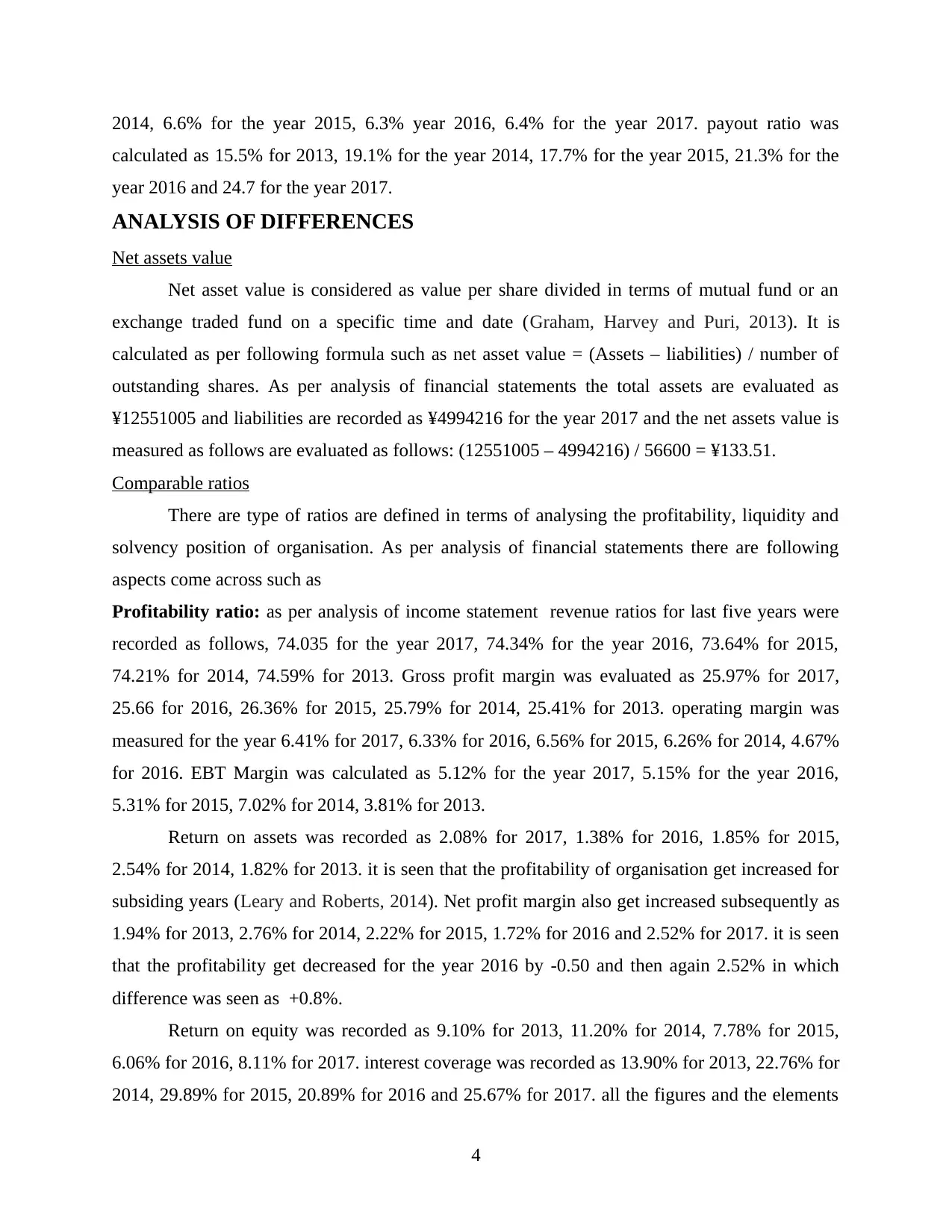
2014, 6.6% for the year 2015, 6.3% year 2016, 6.4% for the year 2017. payout ratio was
calculated as 15.5% for 2013, 19.1% for the year 2014, 17.7% for the year 2015, 21.3% for the
year 2016 and 24.7 for the year 2017.
ANALYSIS OF DIFFERENCES
Net assets value
Net asset value is considered as value per share divided in terms of mutual fund or an
exchange traded fund on a specific time and date (Graham, Harvey and Puri, 2013). It is
calculated as per following formula such as net asset value = (Assets – liabilities) / number of
outstanding shares. As per analysis of financial statements the total assets are evaluated as
¥12551005 and liabilities are recorded as ¥4994216 for the year 2017 and the net assets value is
measured as follows are evaluated as follows: (12551005 – 4994216) / 56600 = ¥133.51.
Comparable ratios
There are type of ratios are defined in terms of analysing the profitability, liquidity and
solvency position of organisation. As per analysis of financial statements there are following
aspects come across such as
Profitability ratio: as per analysis of income statement revenue ratios for last five years were
recorded as follows, 74.035 for the year 2017, 74.34% for the year 2016, 73.64% for 2015,
74.21% for 2014, 74.59% for 2013. Gross profit margin was evaluated as 25.97% for 2017,
25.66 for 2016, 26.36% for 2015, 25.79% for 2014, 25.41% for 2013. operating margin was
measured for the year 6.41% for 2017, 6.33% for 2016, 6.56% for 2015, 6.26% for 2014, 4.67%
for 2016. EBT Margin was calculated as 5.12% for the year 2017, 5.15% for the year 2016,
5.31% for 2015, 7.02% for 2014, 3.81% for 2013.
Return on assets was recorded as 2.08% for 2017, 1.38% for 2016, 1.85% for 2015,
2.54% for 2014, 1.82% for 2013. it is seen that the profitability of organisation get increased for
subsiding years (Leary and Roberts, 2014). Net profit margin also get increased subsequently as
1.94% for 2013, 2.76% for 2014, 2.22% for 2015, 1.72% for 2016 and 2.52% for 2017. it is seen
that the profitability get decreased for the year 2016 by -0.50 and then again 2.52% in which
difference was seen as +0.8%.
Return on equity was recorded as 9.10% for 2013, 11.20% for 2014, 7.78% for 2015,
6.06% for 2016, 8.11% for 2017. interest coverage was recorded as 13.90% for 2013, 22.76% for
2014, 29.89% for 2015, 20.89% for 2016 and 25.67% for 2017. all the figures and the elements
4
calculated as 15.5% for 2013, 19.1% for the year 2014, 17.7% for the year 2015, 21.3% for the
year 2016 and 24.7 for the year 2017.
ANALYSIS OF DIFFERENCES
Net assets value
Net asset value is considered as value per share divided in terms of mutual fund or an
exchange traded fund on a specific time and date (Graham, Harvey and Puri, 2013). It is
calculated as per following formula such as net asset value = (Assets – liabilities) / number of
outstanding shares. As per analysis of financial statements the total assets are evaluated as
¥12551005 and liabilities are recorded as ¥4994216 for the year 2017 and the net assets value is
measured as follows are evaluated as follows: (12551005 – 4994216) / 56600 = ¥133.51.
Comparable ratios
There are type of ratios are defined in terms of analysing the profitability, liquidity and
solvency position of organisation. As per analysis of financial statements there are following
aspects come across such as
Profitability ratio: as per analysis of income statement revenue ratios for last five years were
recorded as follows, 74.035 for the year 2017, 74.34% for the year 2016, 73.64% for 2015,
74.21% for 2014, 74.59% for 2013. Gross profit margin was evaluated as 25.97% for 2017,
25.66 for 2016, 26.36% for 2015, 25.79% for 2014, 25.41% for 2013. operating margin was
measured for the year 6.41% for 2017, 6.33% for 2016, 6.56% for 2015, 6.26% for 2014, 4.67%
for 2016. EBT Margin was calculated as 5.12% for the year 2017, 5.15% for the year 2016,
5.31% for 2015, 7.02% for 2014, 3.81% for 2013.
Return on assets was recorded as 2.08% for 2017, 1.38% for 2016, 1.85% for 2015,
2.54% for 2014, 1.82% for 2013. it is seen that the profitability of organisation get increased for
subsiding years (Leary and Roberts, 2014). Net profit margin also get increased subsequently as
1.94% for 2013, 2.76% for 2014, 2.22% for 2015, 1.72% for 2016 and 2.52% for 2017. it is seen
that the profitability get decreased for the year 2016 by -0.50 and then again 2.52% in which
difference was seen as +0.8%.
Return on equity was recorded as 9.10% for 2013, 11.20% for 2014, 7.78% for 2015,
6.06% for 2016, 8.11% for 2017. interest coverage was recorded as 13.90% for 2013, 22.76% for
2014, 29.89% for 2015, 20.89% for 2016 and 25.67% for 2017. all the figures and the elements
4
⊘ This is a preview!⊘
Do you want full access?
Subscribe today to unlock all pages.

Trusted by 1+ million students worldwide
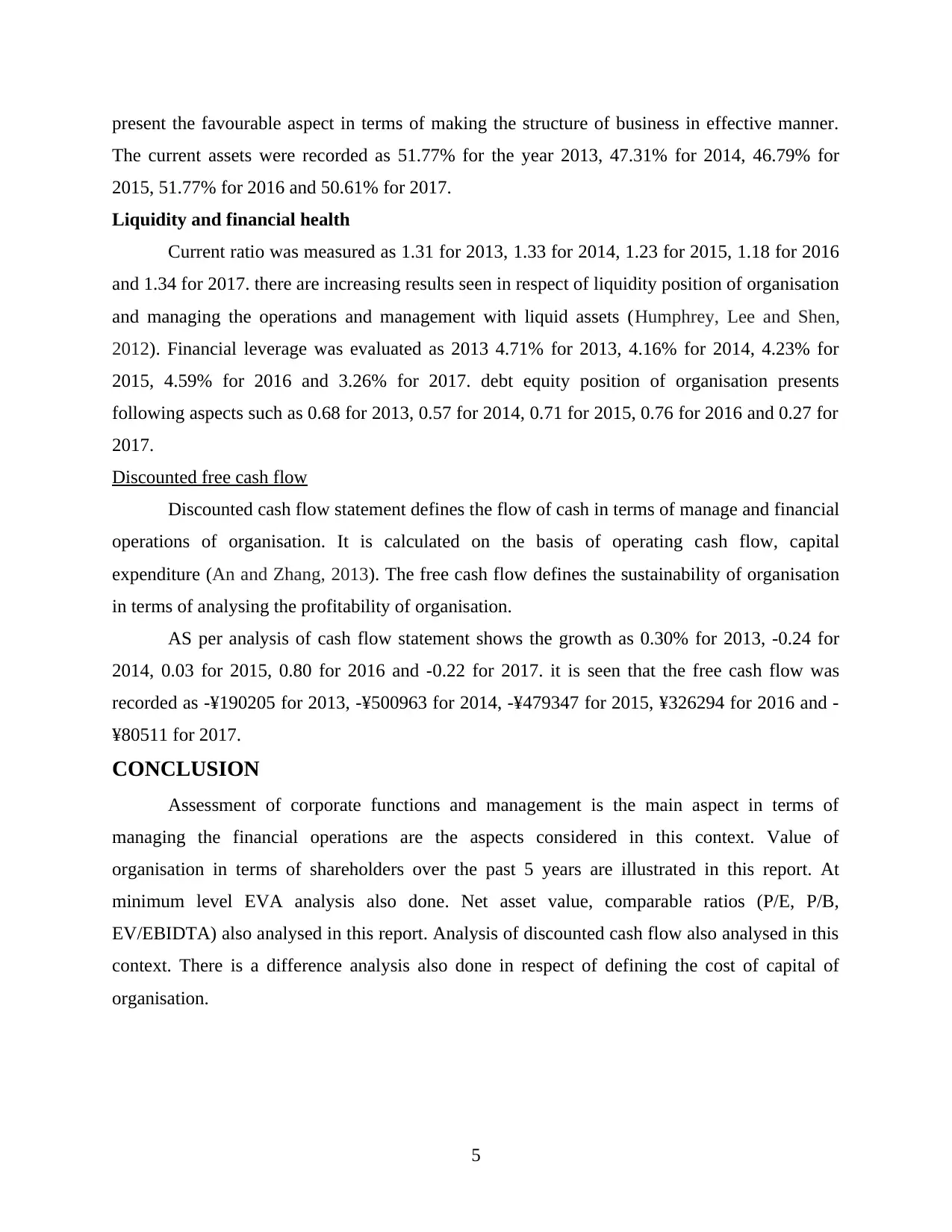
present the favourable aspect in terms of making the structure of business in effective manner.
The current assets were recorded as 51.77% for the year 2013, 47.31% for 2014, 46.79% for
2015, 51.77% for 2016 and 50.61% for 2017.
Liquidity and financial health
Current ratio was measured as 1.31 for 2013, 1.33 for 2014, 1.23 for 2015, 1.18 for 2016
and 1.34 for 2017. there are increasing results seen in respect of liquidity position of organisation
and managing the operations and management with liquid assets (Humphrey, Lee and Shen,
2012). Financial leverage was evaluated as 2013 4.71% for 2013, 4.16% for 2014, 4.23% for
2015, 4.59% for 2016 and 3.26% for 2017. debt equity position of organisation presents
following aspects such as 0.68 for 2013, 0.57 for 2014, 0.71 for 2015, 0.76 for 2016 and 0.27 for
2017.
Discounted free cash flow
Discounted cash flow statement defines the flow of cash in terms of manage and financial
operations of organisation. It is calculated on the basis of operating cash flow, capital
expenditure (An and Zhang, 2013). The free cash flow defines the sustainability of organisation
in terms of analysing the profitability of organisation.
AS per analysis of cash flow statement shows the growth as 0.30% for 2013, -0.24 for
2014, 0.03 for 2015, 0.80 for 2016 and -0.22 for 2017. it is seen that the free cash flow was
recorded as -¥190205 for 2013, -¥500963 for 2014, -¥479347 for 2015, ¥326294 for 2016 and -
¥80511 for 2017.
CONCLUSION
Assessment of corporate functions and management is the main aspect in terms of
managing the financial operations are the aspects considered in this context. Value of
organisation in terms of shareholders over the past 5 years are illustrated in this report. At
minimum level EVA analysis also done. Net asset value, comparable ratios (P/E, P/B,
EV/EBIDTA) also analysed in this report. Analysis of discounted cash flow also analysed in this
context. There is a difference analysis also done in respect of defining the cost of capital of
organisation.
5
The current assets were recorded as 51.77% for the year 2013, 47.31% for 2014, 46.79% for
2015, 51.77% for 2016 and 50.61% for 2017.
Liquidity and financial health
Current ratio was measured as 1.31 for 2013, 1.33 for 2014, 1.23 for 2015, 1.18 for 2016
and 1.34 for 2017. there are increasing results seen in respect of liquidity position of organisation
and managing the operations and management with liquid assets (Humphrey, Lee and Shen,
2012). Financial leverage was evaluated as 2013 4.71% for 2013, 4.16% for 2014, 4.23% for
2015, 4.59% for 2016 and 3.26% for 2017. debt equity position of organisation presents
following aspects such as 0.68 for 2013, 0.57 for 2014, 0.71 for 2015, 0.76 for 2016 and 0.27 for
2017.
Discounted free cash flow
Discounted cash flow statement defines the flow of cash in terms of manage and financial
operations of organisation. It is calculated on the basis of operating cash flow, capital
expenditure (An and Zhang, 2013). The free cash flow defines the sustainability of organisation
in terms of analysing the profitability of organisation.
AS per analysis of cash flow statement shows the growth as 0.30% for 2013, -0.24 for
2014, 0.03 for 2015, 0.80 for 2016 and -0.22 for 2017. it is seen that the free cash flow was
recorded as -¥190205 for 2013, -¥500963 for 2014, -¥479347 for 2015, ¥326294 for 2016 and -
¥80511 for 2017.
CONCLUSION
Assessment of corporate functions and management is the main aspect in terms of
managing the financial operations are the aspects considered in this context. Value of
organisation in terms of shareholders over the past 5 years are illustrated in this report. At
minimum level EVA analysis also done. Net asset value, comparable ratios (P/E, P/B,
EV/EBIDTA) also analysed in this report. Analysis of discounted cash flow also analysed in this
context. There is a difference analysis also done in respect of defining the cost of capital of
organisation.
5
Paraphrase This Document
Need a fresh take? Get an instant paraphrase of this document with our AI Paraphraser
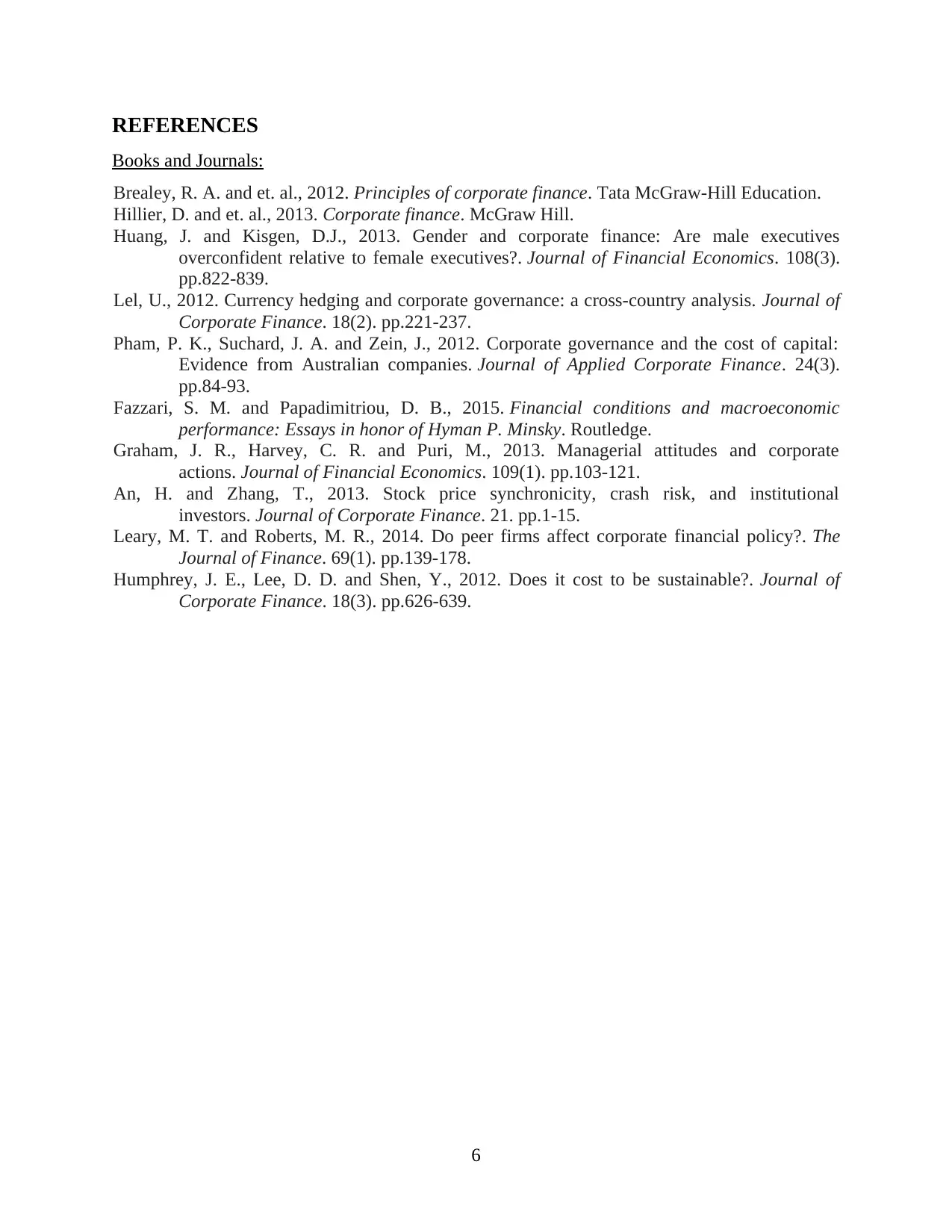
REFERENCES
Books and Journals:
Brealey, R. A. and et. al., 2012. Principles of corporate finance. Tata McGraw-Hill Education.
Hillier, D. and et. al., 2013. Corporate finance. McGraw Hill.
Huang, J. and Kisgen, D.J., 2013. Gender and corporate finance: Are male executives
overconfident relative to female executives?. Journal of Financial Economics. 108(3).
pp.822-839.
Lel, U., 2012. Currency hedging and corporate governance: a cross-country analysis. Journal of
Corporate Finance. 18(2). pp.221-237.
Pham, P. K., Suchard, J. A. and Zein, J., 2012. Corporate governance and the cost of capital:
Evidence from Australian companies. Journal of Applied Corporate Finance. 24(3).
pp.84-93.
Fazzari, S. M. and Papadimitriou, D. B., 2015. Financial conditions and macroeconomic
performance: Essays in honor of Hyman P. Minsky. Routledge.
Graham, J. R., Harvey, C. R. and Puri, M., 2013. Managerial attitudes and corporate
actions. Journal of Financial Economics. 109(1). pp.103-121.
An, H. and Zhang, T., 2013. Stock price synchronicity, crash risk, and institutional
investors. Journal of Corporate Finance. 21. pp.1-15.
Leary, M. T. and Roberts, M. R., 2014. Do peer firms affect corporate financial policy?. The
Journal of Finance. 69(1). pp.139-178.
Humphrey, J. E., Lee, D. D. and Shen, Y., 2012. Does it cost to be sustainable?. Journal of
Corporate Finance. 18(3). pp.626-639.
6
Books and Journals:
Brealey, R. A. and et. al., 2012. Principles of corporate finance. Tata McGraw-Hill Education.
Hillier, D. and et. al., 2013. Corporate finance. McGraw Hill.
Huang, J. and Kisgen, D.J., 2013. Gender and corporate finance: Are male executives
overconfident relative to female executives?. Journal of Financial Economics. 108(3).
pp.822-839.
Lel, U., 2012. Currency hedging and corporate governance: a cross-country analysis. Journal of
Corporate Finance. 18(2). pp.221-237.
Pham, P. K., Suchard, J. A. and Zein, J., 2012. Corporate governance and the cost of capital:
Evidence from Australian companies. Journal of Applied Corporate Finance. 24(3).
pp.84-93.
Fazzari, S. M. and Papadimitriou, D. B., 2015. Financial conditions and macroeconomic
performance: Essays in honor of Hyman P. Minsky. Routledge.
Graham, J. R., Harvey, C. R. and Puri, M., 2013. Managerial attitudes and corporate
actions. Journal of Financial Economics. 109(1). pp.103-121.
An, H. and Zhang, T., 2013. Stock price synchronicity, crash risk, and institutional
investors. Journal of Corporate Finance. 21. pp.1-15.
Leary, M. T. and Roberts, M. R., 2014. Do peer firms affect corporate financial policy?. The
Journal of Finance. 69(1). pp.139-178.
Humphrey, J. E., Lee, D. D. and Shen, Y., 2012. Does it cost to be sustainable?. Journal of
Corporate Finance. 18(3). pp.626-639.
6
1 out of 8
Related Documents
Your All-in-One AI-Powered Toolkit for Academic Success.
+13062052269
info@desklib.com
Available 24*7 on WhatsApp / Email
![[object Object]](/_next/static/media/star-bottom.7253800d.svg)
Unlock your academic potential
Copyright © 2020–2025 A2Z Services. All Rights Reserved. Developed and managed by ZUCOL.




